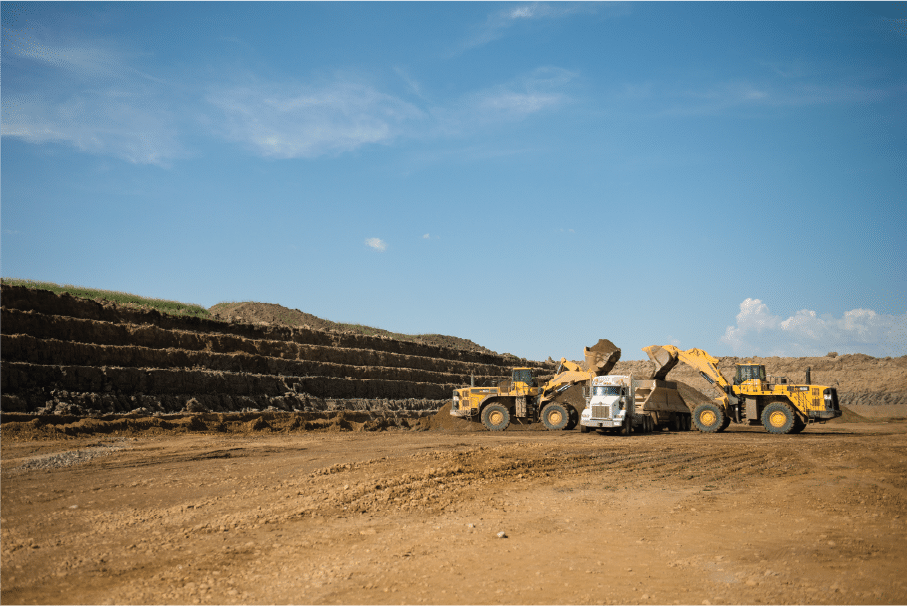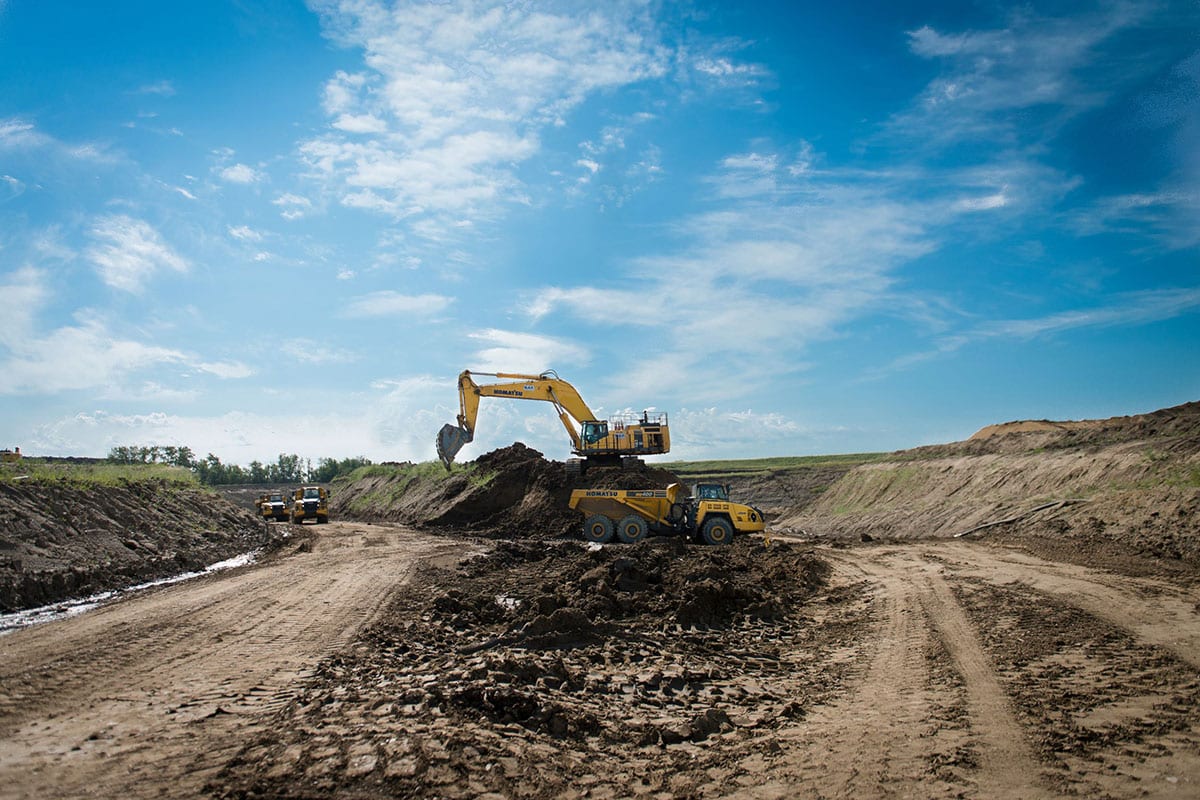Sturgeon County’s approach to resource extraction balances the economic benefits of sand and gravel (aggregate) extraction with the need to protect the environment and residents’ quality of life.
Resource extraction is important. It creates jobs, provides the resources needed to build infrastructure like roads, and helps pay for community services. It also has the potential to impact residents. We’ve heard from residents concerned with loud noise, hours of operation, air and water quality, traffic and impacts to livestock.
The County’s approach to resource extraction balances these considerations and provides the public with opportunities to provide input. Operators must regularly share information with the public throughout the life of an operation.
Rules for Resource Extraction
The below rules don’t necessarily apply to existing operations in the resource extraction land use district, unless they need permit renewal.
Community Involvement
Members of the public have several opportunities to provide input on new resource extraction operations.
- If applying to rezone land to the resource extraction direct control (RE-DC) district, operators must host an open house to provide information and hear from the community before applying.
- The County holds a public hearing for each application to redistrict land so residents can share input with Council before a decision is made. These hearings are advertised in local newspapers, posted to the Sturgeon County website and shared on social media.
Information Sharing
Operators must regularly share information with the public through community meetings and information sharing.
- Annual community event: Each operator must hold at least one community event each year for the surrounding community and must allow landowners to ask questions. All landowners within 1.6 kilometres of the operation and adjacent to haul routes will be invited via a direct-mailed invitation sent at least two weeks in advance of the event. The operator must provide a summary of the community event to the County.
- Information updates: The operator must share information on a semi-annual basis via mail to all landowners within 1.6 kilometres of the operation and adjacent to the haul routes. This communication will provide information about quarterly monitoring or reporting results, where required, and any changes that may impact surrounding landowners.
Setbacks: Distance from Homes and Agricultural Operations
Operators can apply to redistrict land to the resource extraction land use district or to the resource extraction direct control land use district. Each have different requirements for the distance between operations and homes/agricultural operations.
- In the resource extraction (RE) land use district:
- Sand, gravel and clay operations must be at least 400 metres from homes.
- Silica sand operations must be at least 800 metres from homes.
- Operators need to have plans for traffic management, hauling and water/groundwater management.
- In the resource extraction direct control (RE DC) land use district, on a site-specific basis:
- Operators can propose reduced setback distances (compared to the resource extraction (RE) land use district) if supported by an economic, environmental and social assessment. If approved by Council, additional measures could apply and would suit the land’s unique characteristics, such as topography, shelter belts, roadways and more.
- Measures related to traffic management, noise, hours of operation, air quality, hauling, water/groundwater management and more can be applied to reduce the operation’s impact on the environment and nearby landowners and properties.
- Operations within 400 metres of a confined feeding operation must have an agricultural impact assessment. This evaluates the impacts of resource extraction on confined feeding operations. It is used to help make decisions about the proposed operation, and to set measures that can limit impacts.
Hours of Operation / Hauling
In the resource extraction (RE) land use district:
- Operations can operate 24 hours a day, seven days a week.
- Secondary processing, which includes crushing, screening, washing and sorting extraction materials, can generally operate for 12 continuous hours on weekdays unless otherwise supported. Where extended hours are being considered, there will be consideration of site characteristics and impacts on nearby landowners.
- Hauling is generally allowed between 6 a.m. and 6 p.m. on weekdays, and between 8 a.m. and 4 p.m. on weekends and holidays.
In the resource extraction direct control (RE DC) land use district:
- Operations and secondary processing can operate between 6 a.m. and 10 p.m. on weekdays, and between 7 a.m. and 6 p.m. on weekends and holidays. Where extended hours are being considered, there will be consideration of site characteristics and impacts on nearby landowners.
- Hauling is generally allowed between 6 a.m. and 6 p.m. on weekdays, and between 7 a.m. and 5 p.m. on weekends and holidays.
Impacts to Roads
Sturgeon County requires road use agreements when the haul route(s) use County roadways. Haulers can generally travel up to 60 kilometres per hour, and operators must maintain the roads daily during haulage. The operator is responsible for dust suppression on all gravel roads along the haul route(s).
Groundwater Monitoring
Operators must comply with Sturgeon County’s Groundwater Monitoring Program Policy. The County-led groundwater monitoring program helps limit adverse impacts to water quality and quantity. This involves having an independent hydrogeologist conduct regular groundwater sampling, reporting, testing and monitoring. Operators fund these actions, and the groundwater monitoring reports are available to the public (see below). Operators must comply with this program, in addition to provincial requirements for water quality as set by the Water Act.
Noise
The operator must prevent noise from negatively impacting nearby landowners. Measures the operator can take include locating stockpiles and berms to act as sound barriers and taking steps to minimize or reduce noise created by machinery and equipment. Operators may be required to install noise monitors. Engine retarder brakes cannot be used within 500 metres of a home or where indicated with signage.
In the resource extraction direct control (RE DC) land use district, noise generally cannot exceed the following:
- 75 decibels A between 7 a.m. and 7 p.m. on weekdays
- 55 dBA on weekends and between 7 p.m. to 7 a.m. on weekdays
Air Quality
The operator must comply with provincial requirements for air quality and, where required, install air quality monitors.
Permit Expiry / Renewal
Approved resource extraction development permits are valid for five-years. Upon expiry, operators need to apply for a renewal permit to continue operations.
Reclamation
Operators must detail their plans to reclaim the land as part of their development permit application. County Council approves end land use, and operators reclaim land according to provincial reclamation requirements.
Monitoring & Enforcement
The County monitors operations and enforces bylaws for all operations. If the public has concerns about an operation, they can contact Planning and Development Services at 780-939-8275.
Review and Approval Process
Operators can apply at the same time to municipalities and the provincial government.
- Operators may be required to consult the community before applying to redistrict land for resource extraction, if applying to redistrict to the Resource Extraction Direct Control district.
- Operators apply to redistrict land for resource extraction.
- A proposed bylaw goes to Council for consideration of first reading.
- The County holds a public hearing for each application to redistrict land so residents can share input with Council before a decision is made. These hearings are advertised in local newspapers, posted to the Sturgeon County website and shared on social media.
- The proposed bylaw goes to Council for consideration of second and third reading.
- If approved, the operator can apply for a development permit.
- Renewal every five years until the pit is depleted.
- Reclamation certificate application to the province. The lands must be in end state or crop production for two years prior to the province issuing a reclamation certificate.
- Operators apply to have the land redistricted back to the previous land use, or determined end land use.
Municipal and Provincial Regulations
Resource extraction is regulated at the provincial and local levels. Outside of land use, most regulations are set at the provincial level.
Provincial Regulations
The following provincial regulations apply to resource extraction:
- Code of Practice for Pits
- Environmental Protection and Enhancement Act
- Conservation and Reclamation Regulation
- Water Act
Learn more about provincial regulations for resource extraction.
Municipal Regulations
Sturgeon County’s Land Use Bylaw and supporting policies detail the rules and standards for resource extraction in the County.
Common Questions
Who decides where resource extraction operations are located?
Operators either obtain land or lease land where resources are naturally located. A landowner or leaseholder can apply to redistrict/rezone their land. After considering public input, Council decides if the application is supported or not. If approved, Council would pass a bylaw to amend the Land Use Bylaw to reflect the redistricting/rezoning of the land and may apply performance standards related to the specific district.
The landowner or leaseholder must still apply for a development permit. The development permit details the specific conditions for the intended use and is issued by a development officer with the County.
Where are the existing resource deposits within Sturgeon County?
This map shows potential resource deposits in Sturgeon County. There may be deposits in other areas not shown on the map, and some areas on the map may only have small deposits. Not all deposits are practical or cost-effective to extract.
How far do operations have to be from homes?
The setback distances in the resource extraction (RE) land use district are as follows:
- Sand, gravel and clay operations must be at least 400 metres from homes.
- Silica sand operations must be at least 800 metres from homes.
In the resource extraction direct control (RE DC) land use district, on a site-specific basis:
- Operators can apply for reduced setback distances (compared to the resource extraction (RE) land use district) if supported by an economic, environmental and social assessment. If approved by Council, additional measures could apply and would suit the land’s unique characteristics, such as topography, shelter belts, roadways and more.
- Measures related to traffic management, noise, hours of operation, air quality, hauling, water/groundwater management and more can be applied to reduce the operation’s impact on the environment and nearby landowners and properties.
- Operations within 400 metres of a confined feeding operation must have an agricultural impact assessment. This evaluates the impacts of resource extraction on confined feeding operations. It is used to help make decisions about the proposed operation, and to set measures that can limit impacts.
Do adjacent landowners need to support a redistricting/rezoning application?
Landowner support of a rezoning/redistricting application is not always needed, but it can impact Council’s decision.
In the resource extraction direct control district, setback distances can be reduced from those in the resource extraction district. Industry representatives and landowners may negotiate with one another in the pre-application stage; the County/Council is not privy to or involved in these negotiations. Sturgeon County encourages landowners to participate in any consultations and public hearings for resource extraction operations near their property.

